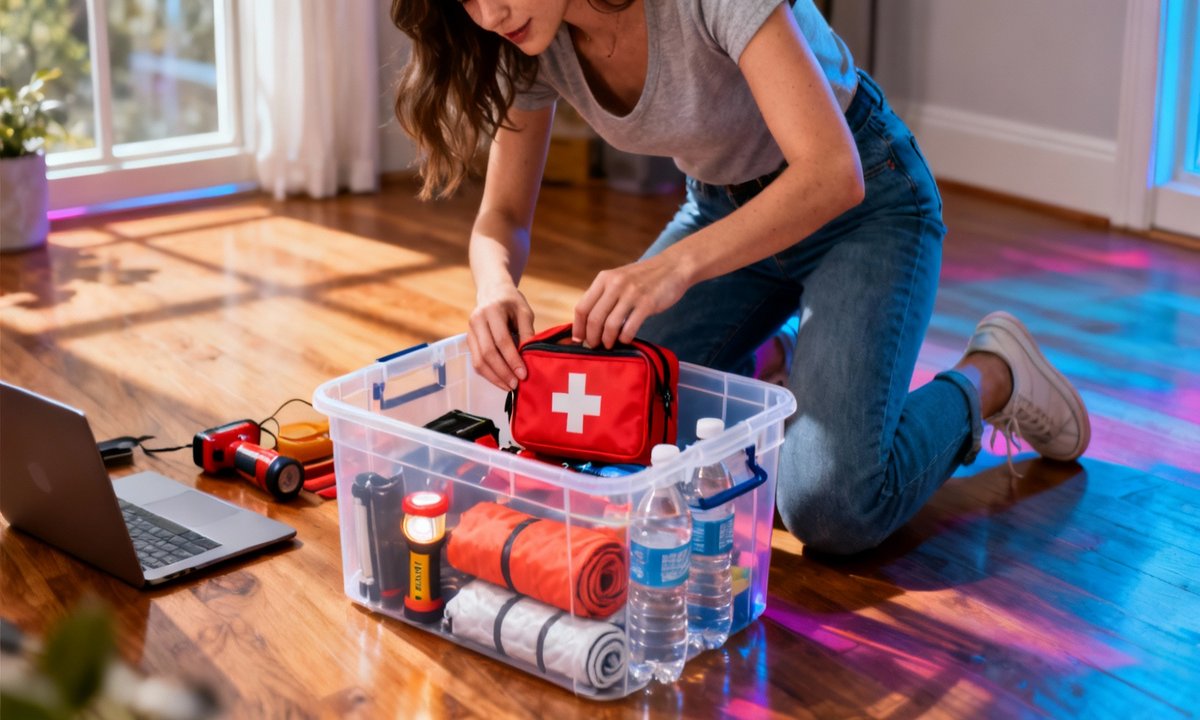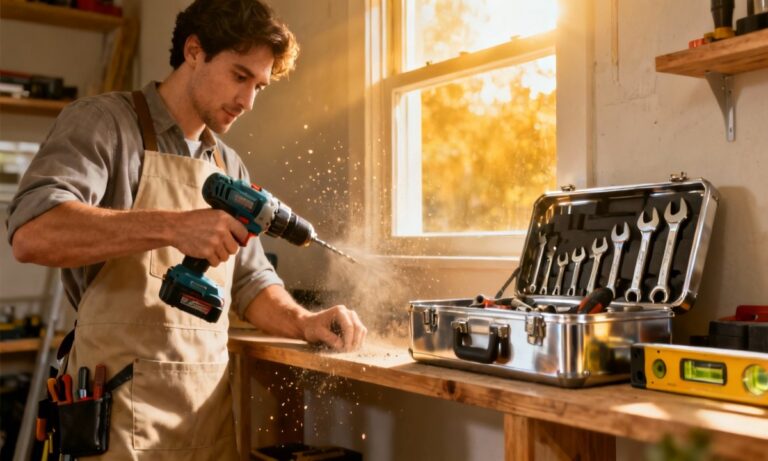Emergencies can arise unexpectedly, from hurricanes to power outages or sudden evacuations. A well-assembled emergency preparedness kit is crucial for protecting your family. Trusted organizations emphasize the importance of having a home emergency kit tailored to your household’s unique needs. This provides practical support and reassurance during stressful situations.
This guide will help you create a comprehensive emergency supplies list, covering everything from fundamental items to specialized considerations. We offer practical tips, easy-to-use checklists, and essential planning advice, linking to valuable resources for every step of your preparedness journey.
Understanding the Importance of a Home Safety Kit
Across the United States, natural disasters and power outages are becoming more frequent. From western wildfires to severe midwestern storms, being unprepared is not an option. A comprehensive disaster preparedness kit ensures every household member, including pets, has essential support for at least 72 hours.
Having immediate access to vital supplies can significantly reduce panic and potentially save lives during chaotic times. It’s also important to think about items often overlooked until a crisis hits. For example, a NOAA Weather Radio provides critical updates when electricity is unavailable.
Furthermore, your emergency safety kit should be customized to address specific local hazards. Families residing in areas prone to earthquakes, tornadoes, or floods will benefit from including items relevant to those particular risks. Preparedness means tailoring your kit to your environment.
Your Essential Home Safety Kit Checklist
Building a robust survival kit for home is straightforward with a clear checklist. Prioritize items to ensure your family’s well-being for at least 72 hours, extending to two weeks if possible.
Core Emergency Kit Supplies
Water: One gallon per person per day, with a minimum of three days for evacuation and two weeks for staying at home.
Non-perishable Food: Easy-to-prepare options, similarly stocked for three days to two weeks.
First Aid Kit: Include bandages, antiseptic wipes, any essential medications for a seven-day supply, a thermometer, and basic tools.
Emergency Radio: A battery-powered or hand-crank model, preferably a NOAA Weather Radio, for vital updates.
Flashlight and Extra Batteries: Lightweight, dependable lighting is crucial during power outages.
Cell Phone with Charger: Pack power banks or solar chargers to keep devices operational.
Personal Documents: Store important IDs, medication lists, and insurance details in a waterproof bag.
Emergency Cash: Small denominations and coins are essential when electronic payments are unavailable.
Local Maps: Paper maps are invaluable for navigation if GPS systems fail.
Sanitation and Hygiene: Towelettes, hand sanitizer, toilet paper, and garbage bags maintain cleanliness.
Extra Clothing and Bedding: Include weather-appropriate changes and sturdy shoes for all family members.
Multi-purpose Tool and Manual Can Opener: These versatile tools address various basic needs.
Whistle: An effective way to signal for help in emergencies.
A visual or printable checklist can greatly assist in assembling your home emergency kit efficiently. (Find our downloadable PDF resource below for quick reference.)
Supplemental Emergency Kit Items for Added Safety
Beyond the core essentials, consider these additions to enhance your family’s safety and comfort:
N95 or surgical masks: For protection against airborne particles.
Rain gear: To stay dry and warm in adverse weather.
Work gloves: For protection during cleanup or minor repairs.
Tools for home safety: Such as a wrench, pliers, and duct tape for immediate needs.
Entertainment and comfort: Books or games, especially for children, can help maintain morale.
ABC-type fire extinguisher: A critical safety device for addressing small fires.
Customizing Your Emergency Kit for Family Needs
Each family possesses unique needs that are central to effective family emergency preparedness. Tailoring your kit ensures everyone receives the specific support they require during a crisis.
Special Considerations for Children
For households with young ones, remember to include items like baby formula, an ample supply of diapers, and child-friendly non-perishable foods. Small games or books can also provide crucial comfort and distraction during stressful times.
Support for Elderly and Disabled Family Members
When preparing for elderly or disabled individuals, ensure your kit contains essential items such as extra hearing aid batteries, necessary mobility aids, and copies of all critical medication prescriptions. Easy access to these supplies is paramount.
Preparing for Your Beloved Pets
Do not forget your furry companions. A dedicated pet emergency kit should include their food, water, a leash, a carrier, and identification tags. For additional guidance, explore our guide on The Modern Pet Parent’s Guide: Essential Gadgets for a Happy & Healthy Home.
Always keep vital medical instructions and emergency contact information in a waterproof bag that is easily accessible. Think about including specialty foods, specific allergy medications, and comforting personal items for every family member to ensure peace of mind.
For tips on efficient storage and organization, consider reviewing Declutter Your Life: Essential Home Organization Tools for a Tidy Space. Proper organization ensures your emergency safety kit is easy to locate and retrieve when every moment counts.
Storing and Maintaining Your Emergency Safety Kit
The optimal location for your emergency safety kit is a known spot, easily accessible to all family members, ideally near your primary exit. Soft-sided duffel bags or rolling backpacks are recommended for effortless transport during any evacuation.
Essential Maintenance Practices
Maintain airtight packaging for all food and medical items to maximize their shelf life. Regularly rotate water and medical supplies every six months to ensure freshness and efficacy.
Consider assembling smaller, supplementary kits for your vehicles and workplace, as emergencies often occur away from home. Annually, or following any disaster, thoroughly reevaluate your emergency kit to ensure its continued relevance and completeness.
Label all items clearly with their expiration dates and keep a printed inventory inside each bag. Utilizing digital reminders can be an effective way to prompt the rotation of supplies before they expire, ensuring your kit is always ready.
Key Emergency Planning for Family Safety
While your kit is vital, its effectiveness is greatly enhanced by a well-rehearsed family emergency plan. Proactive steps ensure every member knows precisely what actions to take when a disaster unfolds.
Developing Your Family Emergency Plan
Establish designated household meeting spots, both inside and outside your home.
Create and regularly review clear evacuation routes, ensuring everyone is familiar with them.
Develop comprehensive communication plans, covering both digital and hardcopy methods. This includes knowing who to call, when to call, and alternative meeting points if cell service fails.
Practice fire drills and safe evacuation procedures regularly to build muscle memory and confidence.
To further enhance your overall safety, consider consulting Smart Home Security 2025: Essential Devices for a Safe & Connected Household. This resource offers insights into modern home technology that can seamlessly integrate with your existing emergency strategies.
Frequently Asked Questions About Home Emergency Kits
What is the best container for a home emergency kit?
For optimal ease, soft-sided duffel bags or rolling backpacks are highly recommended. They are lightweight and simple to grab during urgent situations. Look for options constructed from water-resistant materials with durable zippers to protect your contents.
How long should emergency supplies last?
For evacuation scenarios, aim to have at least three days’ worth of supplies. If staying at home, strive for a minimum of two weeks’ worth. Remember to rotate food and medications every six months to ensure they remain fresh and effective.
Is it possible to build an emergency kit on a budget?
Absolutely! You can start by focusing on the absolute basics like water, canned food, and a flashlight, then gradually add more items over time. Utilize comprehensive checklists to guide your purchases and consider finding discounts at local stores to save money.
How often should I update my emergency kit?
It is best practice to review and update your kit annually. Additionally, perform an update any time there is a significant household change, such as a new family member, a health change for existing members, or the addition of a pet to your home.
Trusted Resources for Enhanced Preparedness
For further guidance and detailed information on creating an effective emergency preparedness kit, consider these reputable organizations:
American Red Cross: Survival Kit Supplies
FEMA Ready.gov Emergency Kit
National Weather Service: Emergency Supplies List
Virginia Department of Emergency Management
North Carolina State Extension: Disaster Kits
Your Path to Comprehensive Emergency Preparedness
Your expertly assembled emergency preparedness kit stands as your family’s strongest defense against unforeseen events. Take action today: utilize our checklist, meticulously tailor your kit, and thoroughly discuss your emergency plan with loved ones. Each step you take significantly enhances your readiness.
For additional strategies on maintaining an organized home, visit Declutter Your Life: Essential Home Organization Tools for a Tidy Space. You can also explore various smart solutions for preparedness and security featured throughout our site, helping you create a safer environment.
Our website prioritizes universal accessibility, offering content optimized for mobile viewing, downloadable print resources, and screen reader compatibility. Should you require alternative formats, please do not hesitate to contact us; ensuring everyone’s safety and peace of mind is our commitment.
We encourage you to share this vital guide or print it for your family. Proactive preparedness not only saves lives but empowers every household to take meaningful action today.



